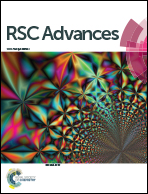Preparation of an ultrathin 2D/2D rGO/g-C3N4 nanocomposite with enhanced visible-light-driven photocatalytic performance†
Abstract
A simple solvent method was developed to construct an ultrathin 2D/2D rGO/g-C3N4 nanocomposite using a suspension of thermally exfoliated g-C3N4 nanosheets and graphene oxide (GO) followed by a NaHSO3 reducing process. Different from the g-C3N4 bulk, the results revealed that the g-C3N4 nanosheets and rGO components in the as-prepared ultrathin nanocomposite have a strong interfacial interaction and abundant coupling interfaces. Moreover, improved visible light absorption properties and fast charge carrier separation efficiency were observed in the ultrathin 2D/2D rGO/g-C3N4 nanocomposite, as compared to the pure g-C3N4 nanosheets, which ensures its enhanced photocatalytic activity for methyl orange (MO) degradation and CO2 photoreduction. It was confirmed that the thermally exfoliated g-C3N4 nanosheet is a good 2D material for the construction of 2D/2D heterostructures.



 Please wait while we load your content...
Please wait while we load your content...